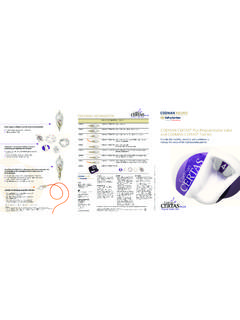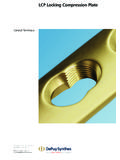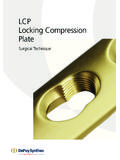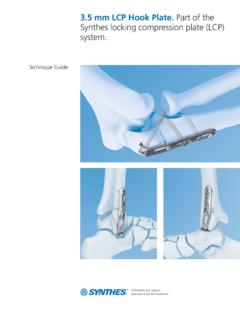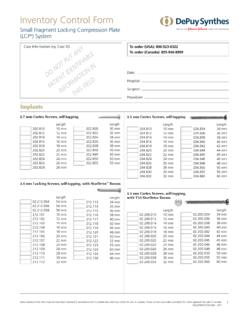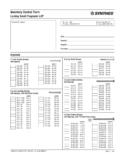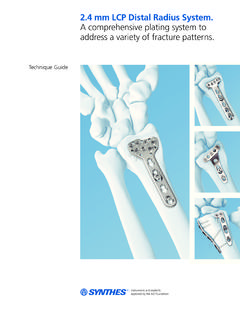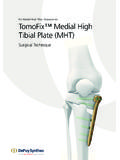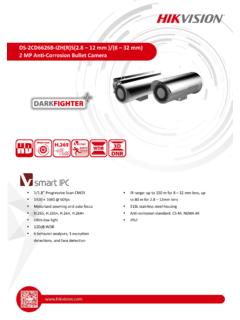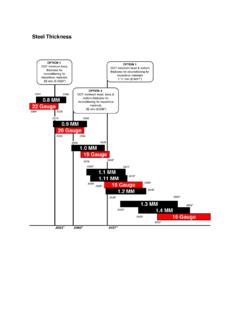Transcription of 2.4 mm and 3.0 mm Headless Compression Screws …
1 Mm and mm Headless Compression Screws . For fixation of small bones and small bone fragments. Technique Guide Table of Contents Introduction mm and mm Headless Compression screw 2. Technique Overview 4. AO Principles 5. Indications 6. Surgical Technique Scaphoid Fixation 7. First Metatarsal Osteotomy 14. screw Removal 20. Product Information Implants 21. Instruments 25. Set Lists 28. Image intensi er control Synthes The mm Self-drilling, Self-tapping, Cannulated Headless Compression screw mm guide wire T8 StarDrive recess mm cortical thread (double thread*). Self-drilling and self-tapping flutes mm shaft Implant quality Titanium alloy 316L stainless steel Ti-6Al-7Nb mm cancellous thread (single thread*).
2 Long thread Short thread Self-drilling and self-tapping flutes * Threads are of equal lead ( they advance the same distance for each revolution). 2 Synthes mm and mm Headless Compression Screws Technique Guide The mm Self-drilling, Self-tapping, Cannulated Headless Compression screw mm guide wire T8 StarDrive recess mm cortical thread (double thread*). Self-drilling and self-tapping flutes mm shaft Implant quality Titanium alloy 316L stainless steel Ti-6Al-7Nb mm cancellous thread (single thread*). Long thread Short thread Self-drilling and self-tapping flutes * Threads are of equal lead ( they advance the same distance for each revolution).
3 Synthes 3. Technique Overview 1 Insert screw 2 Compress 3 Countersink Thread the head of the Headless The tip of the Compression sleeve acts Following Compression of the fracture, Compression screw into the tip as a conventional lag screw head. hold the Compression sleeve stationary of the Compression sleeve. Insert When the tip of the Compression sleeve and use the screwdriver to advance the the screw into the bone using the contacts the bone, the fracture gap screw head into the bone. Compression sleeve construct. is closed and compressed as with a lag screw . 4 Synthes mm and mm Headless Compression Screws Technique Guide AO Principles In 1958, the AO formulated four basic principles, which have become the guidelines for internal Those principles as applied to the mm and mm Headless Compression Screws are: Anatomic reduction A guide wire marks the prescribed path for the cannulated Headless Compression screw and secures the alignment of the fragments while the screw is being inserted.
4 The cannulated Headless Compression screw is inserted over the wire and tightened to further compress the fragments and hold the reduction. Stable fixation Regardless of the size of the fracture gap, cannulated Headless Compression Screws provide interfragmentary Compression and absolute stability. Furthermore, the instrumentation allows the surgeon to directly control the amount of Compression . The Screws are available in different thread lengths, allowing the surgeon to optimize purchase in the far fragment for maximum Compression and stability. Preservation of blood supply The use of small diameter guide wires allows precise placement of the cannulated Headless Compression Screws through small incisions.
5 This technique minimizes disruption of soft tissue and preserves vascular blood flow for bone healing. Early, active mobilization Cannulated Headless Compression Screws , combined with AO technique, provide stable fracture fixation with minimal trauma to vascular supply. This helps to create an improved environment for bone healing, accelerating the patient's return to previous mobility and function. 1. M. E. M ller, M. Allg wer, R. Schneider, and H. Willenegger. AO Manual of Internal Fixation, 3rd Edition. Berlin: Springer-Verlag. 1991. Synthes 5. Indications Synthes mm Headless Compression Screws are indicated for fixation of fractures and nonunions of small bones and small bone arthrodeses, including scaphoid fractures; intra- articular fractures of the tarsals, metatarsals, carpals and metacarpals; bunionectomies and osteotomies; arthrodeses of small joints ( phalanges); fractures of the patella, ulna and radial styloid.
6 Synthes mm Headless Compression Screws are intended for fixation of intra-articular and extra-articular fractures and nonunions of small bones and small bone fragments; Scaphoid nonunion Scaphoid fracture arthrodeses of small joints; bunionectomies and osteotomies, including scaphoid and other carpal bones, metacarpals, tarsals, metatarsals, patella, ulnar styloid, capitellum, radial head and radial styloid. Carpal fusion DIP fusion Calcaneal and talar fractures Bunionectomy Toe fusion Radial styloid fracture 6 Synthes mm and mm Headless Compression Screws Technique Guide Scaphoid Fixation This surgical technique describes a volar approach procedure.
7 Depending on the type and location of the fracture, a dorsal approach to the scaphoid may be preferred. The same surgical steps apply. 1. Insert guide wire Instruments , mm Guide Wire (threaded or nonthreaded). mm / mm Double Drill Sleeve Reduce fragments with a mm guide wire and the mm double drill sleeve using image intensification. Insert the wire from distal-radial to proximal-ulnar until the tip is anchored into the far cortex. Ensure the guide wire lies along the central axis of the scaphoid in the frontal and sagittal planes. Note: Using a pen-style rather than a pistol-grip drive unit may facilitate the insertion of the mm guide wire.
8 Insert the guide wire in 10 mm to 15 mm increments to minimize the possibility of bending the wire. Synthes 7. Scaphoid Fixation continued 2. Drill trapezium (optional). Instruments mm Cannulated Trapezium Drill mm Trapezium Drill Sleeve Handle, with quick coupling If the foot process of the trapezium is prominent, it can be removed with the mm cannulated trapezium drill to ensure central placement of the screw . Slide the trapezium drill through the mm trapezium drill sleeve and over the guide wire to the trapezium. Carefully drill the trapezium by hand to remove interfering bone. Use image intensification to ensure the trapezium drill does not damage the scaphoid.
9 8 Synthes mm and mm Headless Compression Screws Technique Guide 3. Measure screw length Instrument Measuring Device Slide the tapered end of the measuring device over the guide wire to the bone. The reading on the measuring device at the end of the guide wire indicates the screw length which will place the screw tip at the tip of the guide wire. To choose the appropriate screw length, subtract approximately 2 mm to account for fracture gap Compression and the desired countersinking depth. When selecting the shaft thread length, ensure that all threads are past the fracture line during the Compression stage. Correctly selected thread length Incorrect thread length Shaft thread is past the fracture line during Compression .
10 Shaft thread is in the fracture gap. Compression of the fracture gap is not possible. Synthes 9. Scaphoid Fixation continued 4. Drill (optional). Instruments mm Cannulated Drill Bit mm / mm Double Drill Sleeve The self-drilling flutes of the Headless Compression screw make predrilling unnecessary in most cases. Predrilling is recommended in dense bone and in arthrodeses, as the axial force necessary for inserting self-drilling Screws could temporarily distract the fragments. Place the mm double drill sleeve with the mm cannulated drill bit over the guide wire. Drill, using image intensification if necessary. Note: To prevent the guide wire from backing out during drilling, do not over-drill at the tip of the wire, and remove the drill bit slowly.
